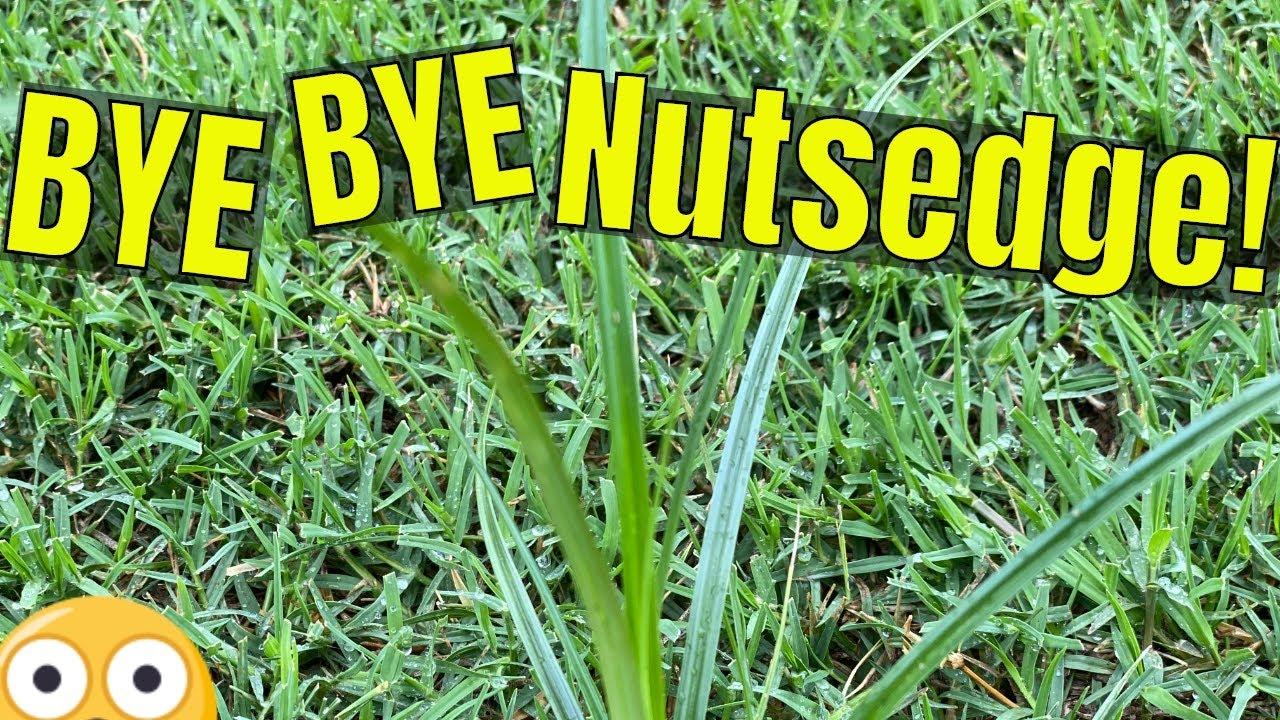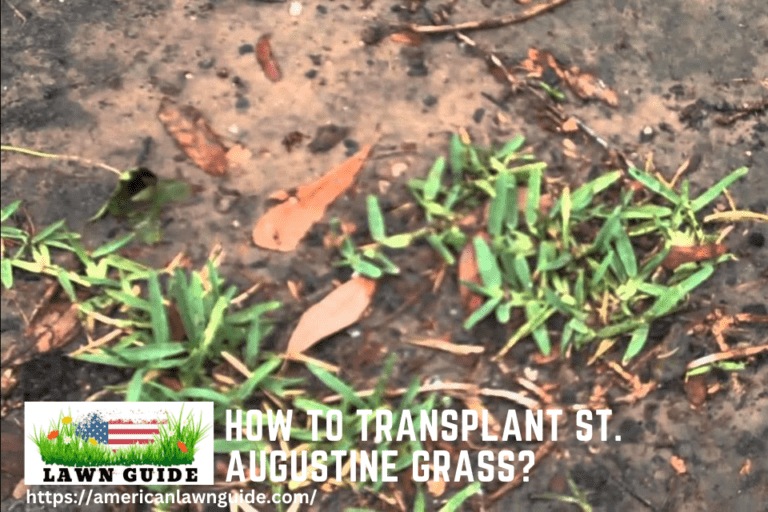Kill nutsedge in Bermuda grass by applying a selective herbicide and ensuring proper lawn care practices. Regular mowing and watering help maintain a healthy lawn.
Nutsedge, often mistaken for regular grass, often called “nutgrass, is a persistent weed that can ruin the appearance of Bermuda grass lawns. It thrives in moist, poorly drained soils and can quickly spread if not controlled. Identifying and eliminating nutsedge early is crucial to maintaining the health and beauty of your lawn.
Selective herbicides target nutsedge without harming Bermuda grass, providing an effective solution. Consistent lawn care, including proper mowing and watering, strengthens the grass, making it less susceptible to weeds. By combining these methods, you can successfully control nutsedge and maintain a lush, green lawn.

Identifying Nutsedge In Your Lawn
Identifying nutsedge in your Bermuda grass is essential. This weed can ruin the look of your lawn. Knowing the differences helps in removing it effectively.
Characteristics Of Nutsedge
Nutsedge has unique features. Here are some characteristics to help you identify it:
- Leaf Shape: The leaves are V-shaped and glossy.
- Color: Bright green, usually lighter than Bermuda grass.
- Growth Pattern: Nutsedge grows upright and quickly.
- Underground Tubers: It has underground tubers called “nutlets.”
Differences Between Nutsedge And Bermuda Grass
To effectively remove nutsedge, you need to know its differences from Bermuda grass. Here’s a table highlighting these differences:
| Feature | Nutsedge | Bermuda Grass |
|---|---|---|
| Leaf Shape | V-shaped and glossy | Flat and rough |
| Color | Bright green | Dark green |
| Growth Pattern | Grows upright | Spreads horizontally |
| Root System | Nutlets | Rhizomes |
By understanding these key differences, you can easily spot and remove nutsedge from your Bermuda grass.

Natural ways to get rid of Nutgrass in your yard
Suppressing nutsedge in Bermuda grass requires more than just herbicides. Cultural practices play a vital role. These practices improve grass health and create unfavorable conditions for nutsedge. Learn how to manage nutsedge using effective cultural methods.
Proper Mowing Techniques
Proper mowing is crucial for Bermuda grass health. Mow regularly and keep grass at the right height. Mow to about 1 to 1.5 inches tall. Do not cut more than one-third of the grass height at once. This reduces stress and helps Bermuda grass outcompete nutsedge.
Optimizing Watering Schedules
Watering schedules impact nutsedge growth. Nutsedge thrives in wet soil. Water deeply but less frequently. This helps Bermuda grass develop deep roots. Water early in the morning to reduce moisture on the surface. This practice keeps the soil drier, inhibiting nutsedge growth.
Enhancing Soil Health
Healthy soil supports strong Bermuda grass. Enhance soil health by maintaining proper pH levels. Bermuda grass prefers a pH of 5.8 to 7.0. Conduct a soil test to determine pH levels. Use lime or sulfur to adjust as needed.
Aerate the soil to improve air and water movement. Aeration reduces soil compaction, promoting healthy root growth. Use organic matter like compost to enrich the soil. Healthy soil makes it harder for nutsedge to establish.
| Practice | Action | Benefit |
|---|---|---|
| Proper Mowing | Keep grass at 1-1.5 inches | Reduces stress and outcompetes nutsedge |
| Watering Schedule | Water deeply, less frequently | Promotes deep roots and drier soil |
| Soil Health | Maintain pH, aerate, add compost | Supports strong grass, inhibits nutsedge |
Chemical Usage Strategies
Using chemical control strategies can effectively eliminate nutsedge in Bermuda grass. This method involves using herbicides to target and kill the stubborn weeds. Proper application and safety measures ensure maximum effectiveness while protecting your lawn and yourself.
Selecting The Right Herbicide
Selecting the right herbicide is crucial for killing nutsedge. Look for herbicides specifically labeled for nutsedge control. Some effective options include:
- SedgeHammer – A selective herbicide that targets nutsedge.
- Basagran – Works well for sedge and broadleaf weeds.
- Image Herbicide – Controls nutsedge and other tough weeds.
Ensure the herbicide is safe for Bermuda grass. Read the label carefully to check compatibility.
Application Tips For Maximum Effectiveness
Follow these tips to ensure your herbicide application is effective:
- Timing: Apply herbicide when nutsedge is actively growing.
- Weather: Choose a calm day with no rain forecasted.
- Coverage: Ensure even coverage of the affected areas.
- Watering: Avoid watering the lawn immediately after application.
Applying herbicide correctly increases its effectiveness and prevents nutsedge from returning.
Safety Measures During Herbicide Use
Using herbicides safely protects you and the environment. Follow these safety measures:
- Wear protective gear: Gloves, goggles, and long sleeves.
- Read the label: Follow all instructions and warnings.
- Store properly: Keep herbicides out of reach of children and pets.
- Dispose of containers: Follow local guidelines for disposal.
Taking these precautions ensures safe and effective use of herbicides in your lawn care routine.
Maintenance And Prevention
Proper maintenance and prevention are key to killing nutsedge in Bermuda grass. With regular care, you can keep your lawn healthy and nutsedge-free. Here’s how to achieve it.
Regular Monitoring For Early Detection
Regular monitoring is crucial for early detection of nutsedge. Check your lawn every week. Look for any signs of nutsedge growth.
- Inspect the lawn closely.
- Identify and remove nutsedge promptly.
- Use a magnifying glass for a detailed inspection.
Cultivating A Thick Bermuda Lawn
A thick Bermuda lawn can naturally suppress nutsedge. Healthy grass competes with weeds for nutrients.
- Fertilize the lawn properly.
- Water deeply but infrequently.
- Mow at the recommended height.
Seasonal Lawn Care Tips
Follow these seasonal tips to keep your Bermuda grass healthy:
| Season | Care Tips |
|---|---|
| Spring | Start fertilizing and mowing. |
| Summer | Water deeply and mow regularly. |
| Fall | Apply pre-emergent herbicides. |
| Winter | Minimize lawn traffic. |

Frequently Asked Questions, How to Get Rid of Nutgrass?
What Is The Best Way To Kill Nutsedge?
Use a herbicide specifically designed for nutsedge, like Sedgehammer. Follow the instructions for best results.
Can I Remove Nutsedge By Hand?
Yes, but it’s difficult. Nutsedge has deep, resilient roots. Hand-pulling might not remove the entire plant.
Does Nutsedge Harm Bermuda Grass?
Yes, nutsedge competes for nutrients and water. It can weaken Bermuda grass and reduce its health and appearance.
How Often Should I Treat Nutsedge?
Treat nutsedge every 4-6 weeks during the growing season. Persistent treatment ensures better control and eradication.
Conclusion
Eliminating nutsedge from Bermuda grass requires diligence and the right approach. Regular maintenance, proper herbicides, and consistent care are key. Healthy Bermuda grass can resist nutsedge better. Follow these steps for a lush, weed-free lawn. Stay dedicated, and your Bermuda grass will thrive, free from the nuisance of nutsedge.




